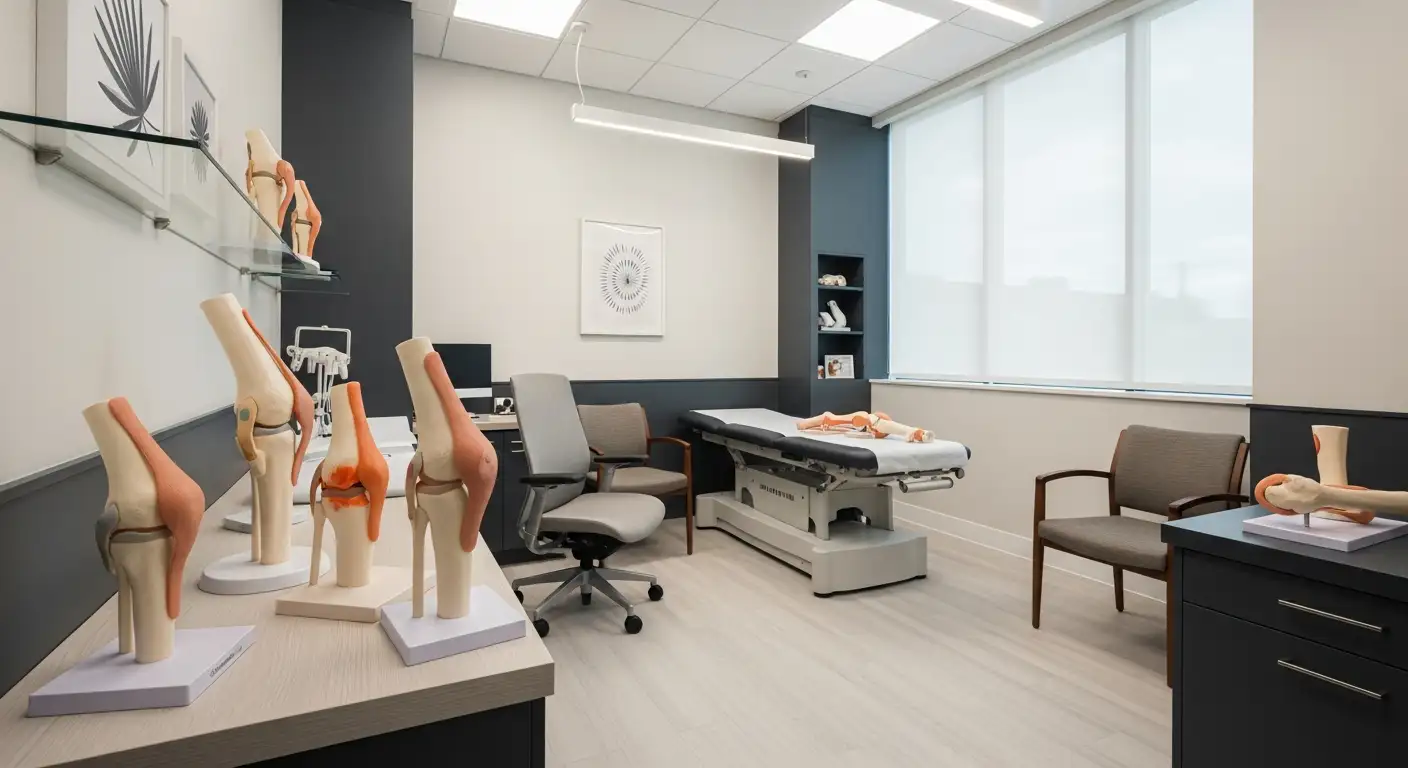Unraveling the Complex Dynamics of Synovitis and Its Impact
Knee osteoarthritis (OA) is a progressive joint disorder characterized by cartilage degradation, but recent research shifts focus towards the active role of synovial inflammation, or synovitis, in disease pathogenesis. This article explores how synovitis contributes to the development, progression, and symptom severity of knee OA, highlighting diagnostic techniques, biological mechanisms, and potential therapeutic targets. Understanding these processes is crucial for advancing treatment strategies aimed not just at symptom relief but also at modifying disease course.
Prevalence and Characteristics of Synovitis in Knee Osteoarthritis
Is synovitis in osteoarthritis curable?
Currently, there is no definitive cure for synovitis in osteoarthritis. This condition involves ongoing inflammation of the synovial membrane that can persist through various stages of the disease. While treatments like NSAIDs and corticosteroids are effective in reducing inflammation and alleviating pain, they do not eradicate synovitis entirely.
Recent research is exploring therapies that specifically target inflammatory mediators and immune responses within the synovium, including biologics such as anti-TNF agents and cytokine inhibitors. These approaches show promise for modifying disease progression, but they are still in development and require further clinical validation.
At present, management of synovitis focuses on symptom control, minimizing inflammation, and improving joint function. In sum, although symptom relief is achievable, eliminating synovitis as a chronic condition remains a current challenge in osteoarthritis treatment.
Histopathological Features of Synovitis in Osteoarthritis

What biological mechanisms and cellular processes are involved in synovitis related to osteoarthritis?
Synovitis in osteoarthritis (OA) is a complex process involving multiple cellular and molecular mechanisms. The inflammatory response is driven by activation of innate immune pathways, especially Toll-like receptors (TLRs) on synovial cells. These receptors respond to cartilage breakdown products and damage-associated molecular patterns, leading to the release of cytokines such as IL-1, TNF-alpha, and IL-6, which promote further inflammation and tissue degradation.
Activation of the complement cascade also plays a role, producing additional inflammatory mediators that damage joint tissues. Immune cells, particularly macrophages, T lymphocytes, and B lymphocytes, infiltrate the synovium. These cells secrete cytokines that perpetuate inflammation and contribute to cartilage and bone destruction.
Histologically, the synovium shows hyperplasia of the lining layer, increased vascularity, and infiltration by mononuclear cells. Neoangiogenesis, or new blood vessel formation, amplifies the inflammatory environment. All these processes create a vicious cycle that exacerbates joint deterioration and pain.
Histopathological features of synovitis
| Feature | Description | Significance |
|---|---|---|
| Thickening of synovial lining | Increased cellular layers leading to hyperplasia of synoviocytes. | Indicates active inflammation and cell proliferation. |
| Increased vascularity | Formation of new blood vessels within the synovium, promoting inflammation. | Enhances immune cell infiltration and sustains inflammatory response. |
| Immune cell infiltration | Presence of macrophages, T-cells, B-cells, and mononuclear cells within the tissue. | Reflects active immune response targeting joint tissues. |
| Synovial hyperplasia | Excessive proliferation of synovial lining cells. | Associated with chronic inflammatory changes. |
| Neoangiogenesis | Formation of new blood vessels supporting inflammatory cell infiltration. | Contributes to persistent inflammation and tissue damage. |
These histological hallmarks, combined with cellular infiltration and mediator expression, underscore the active role of synovitis in the progression of OA. Detecting these changes through biopsy or imaging helps in understanding disease severity and potential therapeutic targets.
Diffuse Nature of Synovitis in Knee Osteoarthritis
Synovitis in osteoarthritis (OA) generally presents as a widespread, diffuse inflammation rather than being confined to specific areas of the joint. This means that the inflammation affects large portions of the synovial membrane, contributing to overall joint swelling, pain, and dysfunction.
Although synovitis tends to be diffuse, it can still show associations with localized cartilage damage, particularly chondral defects. These areas of cartilage deterioration often coincide with regions where inflammatory mediators and immune cells infiltrate, but the inflammation does not remain limited strictly to those sites.
Imaging studies, especially MRI and ultrasound, confirm that synovitis in OA often involves a broad area of the synovial lining. In late-stage OA, severe and extensive synovial inflammation is common, seen during joint replacement surgeries.
Understanding the diffuse pattern is crucial for treatment planning, as therapies targeting synovitis aim to reduce overall joint inflammation rather than focusing solely on localized damage. Effective management may slow disease progression and alleviate symptoms.
What is known about the lymphatic system's role in osteoarthritis and synovitis?
The lymphatic system plays a vital part in joint health by removing excess inflammatory mediators, immune cells, and debris from the synovial tissue. Proper lymphatic drainage helps maintain tissue homeostasis and reduces chronic inflammation.
When lymphatic vessels function efficiently, they prevent the accumulation of inflammatory products that can exacerbate synovitis and tissue destruction. Conversely, impairments in lymphatic drainage may lead to persistent inflammation, which can accelerate the progression of OA.
Research suggests that enhancing lymphatic flow might serve as a therapeutic avenue, potentially decreasing joint inflammation and slowing cartilage degeneration. Therefore, therapies aimed at improving lymphatic function could offer a novel approach to managing OA-associated synovitis.
Imaging Techniques for Detecting Synovitis in OA

What imaging techniques and biomarkers are used to detect and assess synovitis in osteoarthritis?
Detecting and evaluating synovitis in osteoarthritis (OA) relies on several advanced imaging modalities and biomarkers. Among these, contrast-enhanced magnetic resonance imaging (MRI) stands out as the most comprehensive and reliable tool. This technique provides detailed visualization of the synovial membrane, highlighting thickening and increased vascularity that are characteristic of synovitis. It is widely regarded as the reference standard for assessing synovial inflammation, thanks to its ability to detect subtle tissue changes that are often undetectable with other methods.
In addition to contrast-enhanced MRI, conventional MRI sequences have been used with semi-quantitative scoring systems like WORMS (Whole-Organ Magnetic Resonance Imaging Score), MOAKS (Osteoarthritis Research Society International MRI Osteoarthritis Knee Score), and BLOKS (Boston/LOAS Osteoarthritis Knee Score). These scoring systems help quantify the extent of synovial abnormalities, such as hypertrophy, effusion, and blood flow.
Ultrasound is another key imaging technique, providing real-time assessment of the joint. It is highly sensitive for detecting synovial hypertrophy and effusions. Doppler ultrasound further enhances evaluation by visualizing blood flow within the synovium, indicating active inflammatory processes. This modality is useful for dynamic and bedside assessment, and it allows for guided joint injections or aspiration.
Emerging imaging technologies include molecular imaging techniques such as Positron Emission Tomography (PET) and Single Photon Emission Computed Tomography (SPECT). These methods utilize radiotracers that target specific cellular components involved in inflammation, such as activated macrophages or fibroblasts. These advanced tools offer insights into the cellular activity associated with synovitis, potentially providing biomarkers for disease activity.
For biomarker assessment, analysis of synovial fluid and blood samples for cytokines and inflammatory mediators plays a crucial role. Elevated levels of cytokines like IL-1, TNF-alpha, IL-6, and matrix metalloproteinases (e.g., MMP-3) are associated with active inflammation and disease severity. Combining imaging findings with biochemical biomarkers enhances the accuracy of synovitis detection and helps monitor disease progression or response to therapy.
Biomarkers in Synovitis and Osteoarthritis Progression
 Serum markers such as C-reactive protein (CRP) and interleukin-6 (IL-6) are often elevated in patients with osteoarthritis (OA), indicating ongoing systemic inflammation. These biomarkers are associated with disease progression, as higher levels correlate with faster structural joint deterioration.
Serum markers such as C-reactive protein (CRP) and interleukin-6 (IL-6) are often elevated in patients with osteoarthritis (OA), indicating ongoing systemic inflammation. These biomarkers are associated with disease progression, as higher levels correlate with faster structural joint deterioration.
Synovial fluid cytokine levels mirror local inflammatory activity within the joint. Elevated levels of cytokines like IL-1β, tumor necrosis factor-alpha (TNF-α), IL-6, and others such as IL-15, IL-17, and IL-18 have been observed in OA synovium and fluid. These molecules directly contribute to cartilage degradation by stimulating the production of matrix metalloproteinases (MMPs) and other cartilage-destructive enzymes.
Imaging biomarkers are also gaining prominence. Techniques such as MRI enable assessment of synovial tissue volume, thickening, and increased vascularity—hallmarks of inflammation. Quantitative evaluations of synovial hypertrophy and neovascularization serve as useful indicators of disease activity and may predict progression.
Understanding these biological markers helps in characterizing the inflammatory state of OA, monitoring disease activity, and tailoring targeted therapies.
The Contribution of Synovitis to Symptoms and Disease Severity in Knee OA
How does synovial inflammation influence symptoms and severity in osteoarthritis?
Synovitis, the inflammation of the synovial membrane within joints, plays a significant role in shaping the clinical picture of osteoarthritis (OA), especially in the knee. The inflamed synovium produces a variety of inflammatory mediators, such as cytokines and prostaglandins, that sensitize nerve endings in the joint tissues. This process amplifies pain sensations and can also cause joint swelling, warmth, and stiffness.
Patients with active synovitis often report more intense pain and report greater difficulty performing daily activities. Moreover, the presence of synovitis has been linked to rapid progression of joint damage. Imaging techniques like MRI and ultrasound have consistently shown that joints with features of active synovitis tend to have worse clinical symptoms. These findings suggest that inflammation not only causes discomfort but also accelerates structural deterioration, including cartilage loss, which contributes to increased disease severity.
How do imaging findings link synovitis with clinical symptoms?
Advanced imaging modalities such as MRI and ultrasound are crucial for detecting synovitis during early or subclinical stages. MRI can show thickening of the synovial lining and increased vascularity, while ultrasound can detect synovial hypertrophy and effusions with high sensitivity.
Studies demonstrate a clear association: higher grades of synovitis on imaging correlate with more severe pain and functional impairment. In particular, synovial hypertrophy and effusions are linked to higher pain scores, and their presence can predict worsening of symptoms over time.
The ability to visualize and quantify synovitis non-invasively allows clinicians to better understand its impact on patient outcomes. Monitoring the severity of synovitis through imaging can help tailor treatments aimed at reducing inflammation, thereby alleviating symptoms and potentially slowing disease progression.
Relationship Between Synovitis and Osteoarthritis Development and Progression
Can synovitis occur before radiographic changes in osteoarthritis?
Yes, synovitis often appears before visible cartilage damage becomes evident in osteoarthritis. Histological studies show infiltration of mononuclear cells, thickening of the synovial lining, and production of inflammatory cytokines in early stages of OA. Imaging techniques like MRI have detected synovial inflammation, even in knees classified as early osteoarthritis, indicating that synovitis is an early event in disease development.
How does inflammation mediate cartilage degradation and joint structural progression?
Inflammatory mediators produced by the inflamed synovium, such as cytokines IL-1β, TNF-α, IL-6, and others, diffuse into nearby cartilage tissue. These cytokines promote the degradation of the cartilage matrix and inhibit repair mechanisms. Additionally, mediators like VEGF support angiogenesis, which can further exacerbate inflammation and tissue damage. This process creates a cycle of ongoing inflammation and cartilage breakdown, leading to joint deterioration.
What is the role of synovitis in the development and progression of knee osteoarthritis?
Synovitis plays a crucial role early in the course of knee OA, even before cartilage damage is visible on radiographs. It acts as both a marker and a driver of disease advancement by producing inflammatory cytokines and mediators that accelerate cartilage degradation. Evidence from imaging and longitudinal studies shows that synovitis correlates with increased pain, joint dysfunction, and faster structural progression such as cartilage loss and osteophyte formation. Targeting synovial inflammation could, therefore, modify disease trajectory and improve patient outcomes.
Cellular and Molecular Pathways in Synovitis-Driven OA

What biological mechanisms and cellular processes are involved in synovitis related to osteoarthritis?
In osteoarthritis (OA), synovitis is driven by complex cellular and molecular interactions that promote inflammation and tissue degeneration. Central to these mechanisms is the activation of Toll-like receptors (TLRs) on synovial cells. When cartilage and joint tissue breakdown occurs, fragments such as matrix proteins and damage-associated molecular patterns (DAMPs) engage TLRs, triggering an innate immune response.
This activation leads to the secretion of inflammatory cytokines like interleukin-1 (IL-1), tumor necrosis factor-alpha (TNF-α), and interleukin-6 (IL-6), which amplify the inflammatory cascade. These cytokines recruit immune cells such as macrophages, T lymphocytes, and B lymphocytes into the synovium, resulting in infiltration that sustains inflammation.
Another critical pathway involved is the complement cascade, which gets activated by cartilage degradation products. Complement activation results in the generation of pro-inflammatory mediators that further worsen synovial inflammation and joint tissue damage.
The inflammatory milieu stimulates the production of matrix-degrading enzymes like matrix metalloproteinases (MMPs) and aggrecanases (ADAMTS family). These enzymes break down cartilage extracellular matrix components, directly contributing to cartilage erosion. Elevated MMP levels, particularly MMP-1 and MMP-13, are strongly associated with cartilage destruction.
In summary, the biological processes involved include TLR activation, cytokine secretion, immune cell infiltration, and enzymatic degradation of cartilage. These interconnected mechanisms underlie the persistent inflammation and progressive joint damage observed in OA synovitis.
| Pathway | Cellular Components | Impact on OA |
|---|---|---|
| TLR activation | Synovial macrophages, fibroblasts | Initiates inflammatory cytokine production |
| Cytokine secretion | Macrophages, T-cells, B-cells | Promotes immune cell recruitment and inflammation |
| Complement activation | Plasma proteins, immune cells | Exacerbates inflammation and tissue injury |
| Enzymatic cartilage degradation | Chondrocytes, synovial macrophages | Breaks down cartilage matrix, accelerates OA progression |
Understanding these pathways offers potential targets for therapies aiming to reduce synovial inflammation and slow disease progression.
Animal and Clinical Evidence for Synovitis as a Therapeutic Target
Current and emerging therapies targeting synovitis in osteoarthritis (OA) focus on reducing inflammation and modifying disease progression.
Existing treatments include nonsteroidal anti-inflammatory drugs (NSAIDs) and corticosteroids administered intra-articularly. These medications are effective in alleviating the symptoms of synovitis, such as pain, swelling, and joint stiffness, by suppressing the inflammatory response.
Beyond traditional therapies, research has expanded into biologic agents that specifically target cytokines involved in synovial inflammation. For example, anti-IL-1 agents and anti-TNF-α therapies are being investigated to inhibit key inflammatory mediators that drive synovitis and cartilage breakdown.
Emerging strategies also involve innovative delivery systems designed to enhance targeting accuracy and reduce systemic side effects. Nanocarriers and other advanced delivery technologies are under development to deliver anti-inflammatory agents directly to inflamed synovial tissue.
Additionally, immune cell modulation offers a promising avenue. Since synovitis involves infiltration of immune cells such as macrophages, therapies aimed at regulating these cells could provide focused control over inflammatory processes.
In summary, the therapeutic landscape for synovitis in OA encompasses a variety of approaches—ranging from established anti-inflammatory drugs to cutting-edge biologic and delivery system innovations—that aim to effectively manage inflammation and potentially alter the course of the disease.
| Therapy Type | Current Status | Target / Mechanism | Future Potential |
|---|---|---|---|
| NSAIDs and corticosteroids | Widely used, effective | Broad suppression of inflammatory mediators | Continued mainstay, with ongoing improvements |
| Biologics (e.g., anti-IL-1, anti-TNF) | Under investigation | Specific cytokine inhibition to reduce synovial inflammation | Promising for targeted intervention |
| Advanced delivery systems | Experimental/Developmental | Nanocarriers and carriers for localized and sustained drug release | May improve efficacy and reduce side effects |
| Immune cell targeting | Early research stage | Modulation of macrophages and lymphocytes involved in synovitis | Could revolutionize treatments by directly modifying immune responses |
Advances in Imaging Techniques for Monitoring Synovitis Treatment
Imaging modalities play a crucial role in identifying and tracking synovitis in osteoarthritis (OA). Contrast-enhanced MRI is currently regarded as the most reliable method for detecting synovial inflammation, showing detailed visualization of synovial thickening, vascularity, and effusions. Ultrasound (US) offers a high-sensitivity, real-time assessment of synovial hypertrophy and blood flow, making it invaluable for both diagnosis and monitoring response to treatment.
Emerging imaging techniques such as molecular imaging with positron emission tomography (PET) and single-photon emission computed tomography (SPECT) are being developed to visualize cellular and molecular processes within the inflamed synovium. These methods can target specific immune cells like macrophages or fibroblasts, providing insights into the biological activity of synovitis and its response to intervention.
Biomarkers like serum MMP-3 levels and MRI-detected effusion-synovitis volume further complement imaging findings, offering systemic and localized indicators of disease activity. Together, these tools enhance our ability to assess how effective anti-inflammatory treatments are at reducing synovitis and may help predict disease progression.
For further exploration on monitoring synovitis with advanced imaging, the search query "Monitoring synovitis treatment with advanced imaging techniques" is recommended, reflecting ongoing research into optimizing disease management.
Interconnection Between Meniscal Damage and Synovitis in OA

What is the role of synovitis in the development and progression of knee osteoarthritis?
Synovitis plays a significant part in the progression of knee osteoarthritis (OA). It acts as an active component that not only correlates with pain and joint dysfunction but also influences structural deterioration.
Research shows that synovitis mediates the relationship between mechanical joint damage, especially medial meniscus extrusion, and the overall progression of OA. The inflammation in the synovium amplifies joint deterioration by releasing catabolic and inflammatory mediators that accelerate cartilage and bone damage.
Furthermore, synovitis contributes to the formation of osteophytes and increases the risk of cartilage loss, extending its impact beyond initial mechanical injury. This inflammatory response aggravates symptoms and fosters a cycle that promotes disease advancement, making synovitis a vital target for therapeutic interventions aimed at slowing disease progression and alleviating pain.
How does meniscus extrusion relate to OA progression?
Meniscus extrusion, which involves the displacement of the meniscus beyond the tibial plateau, is strongly associated with OA progression. It is considered a mechanical factor that destabilizes the joint and increases stress on articular cartilage.
Studies indicate that medial meniscus extrusion correlates with worsening Kellgren–Lawrence grades and joint space narrowing, markers of OA severity. It also links to increased synovial inflammation, which further drives the degenerative process.
How does synovitis mediate damage progression, especially in meniscus extrusion cases?
In cases of meniscus extrusion, synovitis acts as a crucial mediator. It responds to mechanical stress by becoming inflamed, which then amplifies tissue destruction.
The inflammatory mediators produced can diffuse into cartilage and bone, intensifying degeneration. Notably, recent research uses MRI data to demonstrate that synovitis partly explains how meniscus extrusion leads to disease progression.
This mediating role highlights the importance of targeting synovitis therapeutically, especially in patients with mechanical joint abnormalities like meniscal extrusion, to potentially slow down OA progression and improve clinical outcomes.
Potential Predictive Role of Synovitis in OA Development and Progression
How does synovitis predict incident radiographic osteoarthritis?
Research shows that synovitis, or inflammation of the synovial membrane, can serve as an early warning sign for osteoarthritis (OA). Imaging studies such as MRI and ultrasound have demonstrated that patients with synovitis are more likely to develop visible joint degeneration over time. For example, effusion-synovitis and Hoffa-synovitis detected at baseline or prior to radiographic signs significantly increase the risk of future OA. This relationship is supported by findings where synovial inflammation mediates the progression from initial joint changes to overt disease, sometimes appearing before cartilage damage is evident.
How can imaging and biomarkers help forecast disease course?
Advanced imaging techniques like MRI are invaluable for identifying synovial thickening, vascularity, and inflammation levels. These features correlate with worse joint pain and faster structural deterioration. Biomarkers, such as serum MMP-3 and inflammatory cytokines like IL-6, also provide clues about ongoing inflammation. Elevated levels of these biomarkers, combined with imaging findings, improve the prediction of disease progression. They help in stratifying patients into risk categories, enabling earlier and more targeted intervention, potentially altering the disease’s trajectory.
What is known about the lymphatic system's role in osteoarthritis and synovitis?
Impaired lymphatic drainage can result in the accumulation of inflammatory mediators within the joint, maintaining or intensifying synovial inflammation. Enhancing lymphatic function is proposed as a potential therapeutic approach, aiming to clear inflammatory molecules more efficiently and reduce joint swelling and pain. This systemic aspect of joint health suggests that therapies targeting lymphatic pathways could slow disease progression by resolving persistent inflammation, opening a new frontier in OA management.
| Aspect | Description | Relevance to OA |
|---|---|---|
| Synovitis as Predictor | Synovitis correlates with incident OA | Early detection can guide preventive strategies |
| Imaging Techniques | MRI, ultrasound assess synovitis | Noninvasive tools for risk stratification |
| Biomarkers | MMP-3, cytokines indicate inflammation | Predicts disease course |
| Lymphatic System Role | Drainage affects inflammation clearance | Potential therapeutic target |
Emerging research continues to explore these connections, aiming to improve early diagnosis and control of osteoarthritis by targeting synovial inflammation and its systemic influences.
Future Directions and Research Needs in Synovitis and OA
Can synovitis in osteoarthritis be cured?
Complete relief or cure of synovitis in osteoarthritis (OA) remains an elusive goal. Currently, treatments mainly focus on alleviating symptoms such as pain and joint swelling through nonsteroidal anti-inflammatory drugs (NSAIDs), corticosteroid injections, and physical therapy. These approaches help manage inflammation temporarily but do not address the underlying causes.
However, ongoing research strives to develop therapies that target the inflammatory processes directly involved in synovitis. The aim is to modify the disease course itself rather than merely controlling symptoms, potentially preventing progression and joint deterioration.
Development of disease-modifying therapies.
Future innovations are exploring disease-modifying osteoarthritis drugs (DMOADs) that could target structural inflammation in the synovium. These newer agents may inhibit the production of inflammatory cytokines like IL-1, TNF-alpha, and IL-6, or block immune cell infiltration and activity.
Advances in understanding the molecular pathways involved in synovitis, including immune cell activation and vascular proliferation, are informing candidate drugs. Some experimental therapies involve biologics and targeted small molecules that aim at specific inflammatory mediators. These could potentially slow or halt joint damage and improve long-term outcomes.
Precision medicine targeting specific immune cell subtypes.
Recognizing that synovitis involves various immune cells—like macrophages, T cells, and B cells—research is also moving towards personalized approaches. By identifying specific cell subtypes and their roles within an individual’s inflamed synovium, treatments can be tailored more effectively.
Recent discoveries of distinct macrophage subsets in OA suggest possibilities for selectively inhibiting pro-inflammatory macrophages while sparing or promoting tissue-repairing ones. Advanced imaging and biomarker analysis help define patient-specific inflammatory profiles, paving the way for precision therapeutics.
In summary
Although a cure for synovitis in OA is not yet available, emerging therapies and personalized strategies hold promise. Focused on modifying disease mechanisms at the cellular and molecular levels, future interventions could revolutionize how OA is managed, ultimately aiming for durable disease modification.
To explore more on future therapies for synovitis in osteoarthritis, search for recent studies and reviews using the query “Future therapies for synovitis in osteoarthritis.”
Summing Up the Significance of Synovitis in Knee OA Progression
Synovitis is a pivotal active component in the pathophysiology of knee osteoarthritis, extending beyond mere inflammation to influence pain, structural deterioration, and disease trajectory. The diffuse nature of synovial inflammation, its association with immune cell infiltration, and its detection through advanced imaging and biomarkers have reshaped our understanding of knee OA. Targeting synovitis with anti-inflammatory therapies and innovative drug delivery systems offers promising avenues for modifying disease progression and alleviating symptoms. Ongoing research into the cellular mechanisms involved, the role of the lymphatic system, and predictive biomarkers continues to deepen our insights, inspiring future therapeutic strategies aimed at not just managing symptoms but also changing the course of OA.
References
- The Role of Synovitis in Osteoarthritis - PMC
- Synovitis in osteoarthritis: current understanding with therapeutic ...
- The Role of Synovitis in Osteoarthritis pathogenesis - PubMed Central
- The role of synovitis in osteoarthritis pathogenesis - ScienceDirect.com
- Synovitis: Joint Lining Inflammation Causes & Treatments - HSS
- Imaging of Synovial Inflammation in Osteoarthritis, From the AJR ...
- Synovial Macrophages in Osteoarthritis: The Key to Understanding ...





